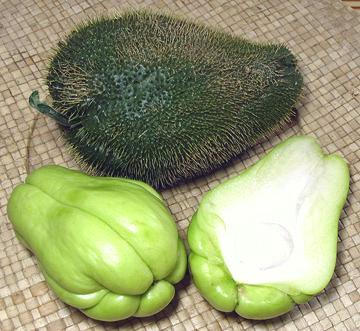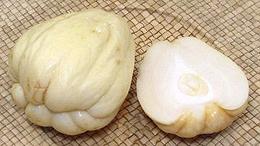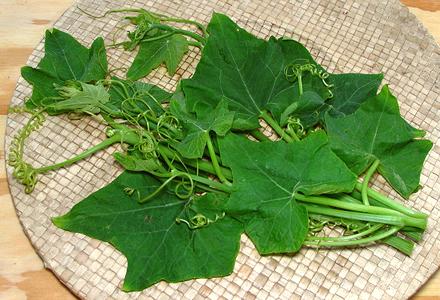Chayote
 [Vegetable Pear, Mango squash (English); Christophene, Cho-cho, Tayota
(Caribbean); Mirliton, Merliton (Cajun, Creole); Choko (Australia);
Chouchou (Africa); Sayota (Philippine); Sayongte, Fak maeo (Thai);
Gurkha Thee (Burma); Gayota (Latin America); Seemai kathrikai, Chow chow,
Bengaluru vankayya (India); Mak su (Laos); Labu siam (Indonesia);
PLU #4761; Sechium edule]
[Vegetable Pear, Mango squash (English); Christophene, Cho-cho, Tayota
(Caribbean); Mirliton, Merliton (Cajun, Creole); Choko (Australia);
Chouchou (Africa); Sayota (Philippine); Sayongte, Fak maeo (Thai);
Gurkha Thee (Burma); Gayota (Latin America); Seemai kathrikai, Chow chow,
Bengaluru vankayya (India); Mak su (Laos); Labu siam (Indonesia);
PLU #4761; Sechium edule]
Pronounced chy-O-tay, this vegetable is technically not a squash because
it belongs to genus C. Sechium not C. Cucurbita, but it's
normally called a squash, and we have nowhere else to put it. An odd squash
it is - it looks like a giant seed. Each "squash" consists of a very large
embryo within a smooth but very soft and thin seed coat, and a thick layer
of flesh over that. A notch is left at the wide end through which the seed
sprouts.
Native to Central America, chayotes are now grown worldwide. and are
quite popular in India and Southeast Asia. The two biggest exporters are
Costa Rica (mostly to Europe) and Veracruz Mexico (mostly to the U.S.).
Guatemala also exports some to the U.S.
 The photo above shows two regular Chayotes, which average about 3 inches
across, 4-3/4 inches long and weight about 9 ounces each. There are also
varieties with dark green skin, called "Guisquil" in Guatemala where they
are grown. These have better flavor than the light green ones, but are seldom
seen here in Southern California. Also from Guatemala are "White Chayota"
(Perulero) shown in the photo to the left.
The photo above shows two regular Chayotes, which average about 3 inches
across, 4-3/4 inches long and weight about 9 ounces each. There are also
varieties with dark green skin, called "Guisquil" in Guatemala where they
are grown. These have better flavor than the light green ones, but are seldom
seen here in Southern California. Also from Guatemala are "White Chayota"
(Perulero) shown in the photo to the left.
The big 2 pound spiky chayote in the top photo has excellent flavor, but
you won't see them in most regions. Some specialty produce stores have them
now and then, but grocery workers hate them because they'll stab you right
through bags and lightweight gloves. Food writers have been endlessly puzzled
by early reports that the chayote was "like a porcupine" because they were
unaware of this variety. There are also a lot of small spiky varieties
which are not in the commercial market.
See also and
, which are also
edible.
More on Squash.
The flavor of chayote fruit is often described as a blend of zucchini,
green bean and cucumber, which is fairly accurate. The flesh is starchy
and stays reasonably firm when cooked. Chayote is rich in vitamins C and
B6, folate, potassium, magnesium and fiber.
Buying:
Chayotes are available in all markets serving
Latin American communities and often in markets serving Southeast Asian
or Indian communities. Look for smooth fresh appearance and no bruises,
soft spots or discoloration. If you can find a variety with dark green
skin it will probably be more flavorful but the light green variety
that dominates the markets. The big spiky variety is available in some
markets that serve a Central American community.
Storing:
They'll keep a few days at room temperature
or about a week refrigerated. They need fairly high humidity so they
won't shrivel.
Prep:
If your chayotes are mature with thick skins you
need to peel them, The toughest skins are easy to remove after cooking,
and very young chayotes with tender skins can be eaten skin-on. In the
middle are most of them, the ones with skins too tough to eat but too
tender to pull off easily.
Most of the skin can be removed with a vegetable peeler, but that in
deep grooves needs to be cut out with a sharp knife. once you have split
the Chayote in half lengthwise on the seam, it is easy to take a
diagonal slice off the big end to remove the skin there (see top photo
bottom right).
I've often read that if you peel them raw they exude a sticky
substance that's difficult to wash off your hands. I've peeled plenty
of fresh Chayotes with a vegetable peeler, but have failed to experience
this substance.
Inside are two large embryonic leaves (cotyledon). If these are
large, they are a tasty morsel with a lightly nutty flavor, generally
eaten by the cook as soon as the chayotes are done, and seldom getting
to the table. The seed coat that surrounds the embryo is soft so need
not be removed.
Prickly Chayotes:
First you want to disarm them by
blasting them with your Kitchen
Torch. They'll still have some stubble but won't stab you.
The vegetable peeler is useless, you have to carve the skin off with
a sharp vegetable knife.
Cooking:
Chayote chunks or slices can be put into soups
and stews raw if simmering time will be at least 20 minutes. Otherwise,
steam or simmer until done, about 20 to 25 minutes, and add to the
recipe when it is almost done.
Chayote is sometimes grated or sliced into thin strips and added to
salads raw, but they are most often cut into cubes or slices and cooked,
even if they will appear on a raw salad plate. They are popular this way
in Southeast Asia.
Chayote Greens
 [pucuk labu (Malay); Long xu cai, Dragon Whiskers Vegetable (Chinese)]
[pucuk labu (Malay); Long xu cai, Dragon Whiskers Vegetable (Chinese)]
These are rather pleasant greens, though a touch coarse, with a basic
flavor similar to the Chayote squash, but, well, greener. They are
suitable for soups and stews as they don't turn to mush within a
reasonable cooking time. I definitely prefer these to Long Bean or
Squash leaves, also found in the Philippine markets.
In Southeast Asia these may be stir fried with garlic, but more
commonly with garlic and dried anchovies or dried shrimp. They are
also prepared with shiitake mushrooms in Vietnam.
Buying:
These are easiest to find in a large Philippine
market, of which we have plenty here in Southern California - because
our entire health care system runs on Philippine immigrants. My local
market puts out bundles of greens on Friday or Saturday morning for sale
over the weekend.
Do not depend on the sign. Various greens tend to get jumbled in the
markets, and they presume their customers know what they're buying.
Note the many straight and curled tendrils (the "dragon whiskers"). The
leaves are medium size, fairly thin, devoid of fuzz, and have a sandpaper
feel on the dark side.
Storing:
Loosely wrapped, these greens will last several
days in the fridge, if they were in good shape to start with.
Prep:
Strip the leaves and tender tips from the tough
stems, discarding the stems. You can use stems at the tip to the point
where they will snap off cleanly. The tendrils can be used, though they
will make your dish a bit coarser, but not the stems they originate from.
Unlike many greens, the leaf stems are not as tough as the main stems,
and those of smaller leaves can be used, again, to the point where they
snap off cleanly.
Cooking:
Simmering time should be about 10 minutes,
though the leaves will still hold together well and are not mushy at
20 minutes. Steaming should be a little longer.
Yield:
A 1 pound 10 ounce bunch yielded 14 ounces
edible (54%), but your bunches may vary. One recipe called for "2
bunches, about 300 grams". Here in Los Angeles, a single bunch can
run 800 grams, so I have no idea what the yield from her bunches
would be.
Chayote Roots
 [Ichintal]
[Ichintal]
The tuberous part of the chayote root is starchy and edible, used
similarly to yams, but for some reason has attracted little attention as
a potential agricultural crop. Perhaps farmers prefer to leave them in
the ground to grow more greens and fruit.
Photo by U.S. Government = Public Domain.
sq_chayotz. 071021 r 141203 r 230307 - www.clovegarden.com
©Andrew Grygus - agryg@clovegarden.com - Photos
on this page not otherwise credited © cg1
- Linking to and non-commercial use of this page permitted
 The photo above shows two regular Chayotes, which average about 3 inches
across, 4-3/4 inches long and weight about 9 ounces each. There are also
varieties with dark green skin, called "Guisquil" in Guatemala where they
are grown. These have better flavor than the light green ones, but are seldom
seen here in Southern California. Also from Guatemala are "White Chayota"
(Perulero) shown in the photo to the left.
The photo above shows two regular Chayotes, which average about 3 inches
across, 4-3/4 inches long and weight about 9 ounces each. There are also
varieties with dark green skin, called "Guisquil" in Guatemala where they
are grown. These have better flavor than the light green ones, but are seldom
seen here in Southern California. Also from Guatemala are "White Chayota"
(Perulero) shown in the photo to the left. [Vegetable Pear, Mango squash (English); Christophene, Cho-cho, Tayota
(Caribbean); Mirliton, Merliton (Cajun, Creole); Choko (Australia);
Chouchou (Africa); Sayota (Philippine); Sayongte, Fak maeo (Thai);
Gurkha Thee (Burma); Gayota (Latin America); Seemai kathrikai, Chow chow,
Bengaluru vankayya (India); Mak su (Laos); Labu siam (Indonesia);
PLU #4761; Sechium edule]
[Vegetable Pear, Mango squash (English); Christophene, Cho-cho, Tayota
(Caribbean); Mirliton, Merliton (Cajun, Creole); Choko (Australia);
Chouchou (Africa); Sayota (Philippine); Sayongte, Fak maeo (Thai);
Gurkha Thee (Burma); Gayota (Latin America); Seemai kathrikai, Chow chow,
Bengaluru vankayya (India); Mak su (Laos); Labu siam (Indonesia);
PLU #4761; Sechium edule]
 [pucuk labu (Malay); Long xu cai, Dragon Whiskers Vegetable (Chinese)]
[pucuk labu (Malay); Long xu cai, Dragon Whiskers Vegetable (Chinese)]
 [Ichintal]
[Ichintal]